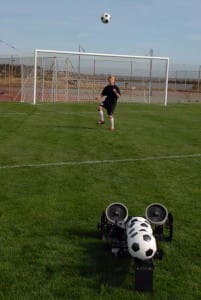Methods for soccer conditioning and training for anaerobic and aerobic energy systems for young soccer players has changed over the years.
We will look at current anaerobic and aerobic conditioning and training for youth soccer players. We will address the common myth about going for a twenty to forty minute jog to build an aerobic base.
The game of soccer is played with intense powerful spurts of energy and active rest periods stressing both the anaerobic and aerobic energy systems. Soccer conditioning and training for young players should be done the way the game is played.
When was the last time you saw a soccer player young or old jog at a steady pace for an entire game? Both the energy system and the muscular system need to be trained according to the demand of the game regardless of the age of player.
Let us take a look at the different type of energy systems and how they influence anaerobic and aerobic soccer conditioning and training for young players.
1. The Phosphagen or ATP-PC System
* This system does not require or need oxygen.
* The chemical fuel source is phosphocreatine and it is stored in the muscle.
* Provides energy for quick short bursts of energy
* Provides maximum power – in soccer this would be a 10 to 20 metre burst from a striker attacking a defense
* Major source of energy for the first 30 seconds of intense exercise.
2. The Anaerobic Glycolytic System
*Glycogen is the fuel source – no Oxygen is required
* Lactic acid and free hydrogen ion produced
* Provides energy for activity of moderate intensity and short duration- in soccer this would a midfielder moving up and down the field a couple of times
* Major source of energy from the 30th second to the 90th second
3.
The Aerobic System
*Carbohydrates, fats and proteins are fuel sources and are utilized in relation to both their availability and intensity of exercise.
*Oxygen is required.
*This system is the major system after the second minute of exercise.
So which system is used in soccer? All three systems are used regardless the age of the youth soccer player.
The Phosphagen energy system is used when strikers sprint 20m to get open in the attacking third.
Midfielders use the anaerobic glycolytic energy system to support both the forwards and defense.
The aerobic energy system is utilized from the beginning of the game to the end of the game for active recovery from the intermittent powerful bursts of energy through out the game.
If we look at the game from beginning to end it is an aerobic sport with anaerobic components. This concept
is overlooked on a continuous basis. If soccer was truly an anaerobic sport games would be finished in two minutes.
Remember anaerobic means with out oxygen. Players need oxygen before they start the game.




